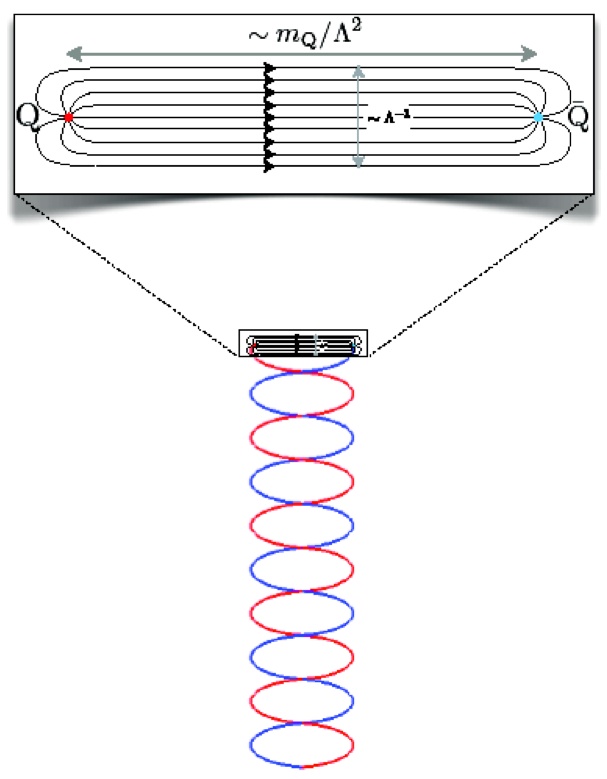Theory
Embedding the Standard Model symmetry group in higher-dimensional theories often results in additional gauge groups at low energy that have observable consequences at collider experiments. For this reason, simple extensions to the Standard Model group are always promising candidates for new physics searches independent of specific models. One such extension is an additional SU(N) with fundamental fermions similar to the quarks of QCD. If the interaction is QCD-like, generic searches for new massive quarks and stable massive particles are likely to have some sensitivity to this possibility.
However, if the confinement scale of the interaction, ?, is small compared to the mass of the fundamental fermions, M Q, QCD-like string breaking by spontaneous production of fermion-antifermion pairs, as in the familiar jet fragmentation of QCD, is exponentially suppressed. In this case, the fermions, called "quirks", are bound in pairs by stable "infracolor" strings. The large range of quirk masses and infracolor confinement scales allowed by previous measurements and cosmological constraints results in widely varied and rather bizarre phenomenologies that present unusual challenges for detection.
Phenomenlogy
For very small confinement scales, the bound state can be macroscopic, with string lengths of several meters. Quirks in such a bound state leave non-helical trajectories in the detector that will be, at least, very challenging to identify and reconstruct. For very large confinement scales, the quirks undergo rapid re-annihilation, resulting in a prompt "hadronic fireball" that will be difficult to distinguish from QCD backgrounds. However, for intermediate confinement scales, the quirk pair is stable but the string length is typically smaller than detector resolutions: approximately 100 microns. These "mesoscopic" quirk pairs therefore interact like a single particle in the detector, resulting in a simple but distinct signature; a trail of high specific ionization (consistent with a very low-momentum particle) along a nearly straight path (consistent with a high-momentum particle).
Strategy
The initial objective is to develop a search for mesoscopic quirks using the ATLAS detector. The strategy is to identify simple and relatively loose identification criteria that provide adequate sensitivity while minimizing the dependence on specific model assumptions and uncertainties in the dynamics of quirk pairs. In time, we hope to expand the search signature to include macroscopic quirks, building on experience and tools developed for this simplest case.
While the background for this signature is expected to be low, there are a number of caveats in detecting mesoscopic quirk pairs in the ATLAS detector. First, a quirk pair must be produced in association with a recoiling photon or jet or the tightly bound pair will be lost down the beampipe undetected. So, we must require a jet in the event, which also provides a missing energy trigger since the quirk pair will not generally be reconstructed at the trigger level.
Second, the quirks move slowly enough that the hits they make in the detector can be out-of-time with respect to particles traveling at the speed of light, a problem that is obviously less severe in the inner layers of the detector. So, the reconstruction technique focuses on the elements of the inner detector: the pixels, SCT and TRT tracking detectors. Finally, the most critical inner layers of the detector, the ATLAS pixels, have limited dynamic range for large dE/dx, so hits from very slow moving quirks can simply be lost. Meanwhile, the internal dynamics of the bound quirk pair lead to some oddities in the energy deposition and trajectories of the quirk pairs that can significantly modify the basic signature. The magnitude of these effects needs to be understood to fully define the signature and the required background samples.
Status
Because understanding the nature of the signal is critical defining both the search strategy and the required background samples, the top priority has been the development of a robust simulation of quirk dynamics that is as complete as possible. Towards this end, we have developed a standalone Monte Carlo simulation of quirk dynamics to better define the ATLAS-specific signature for and sensitivity to mesoscopic quirks. Initial results of this work indicate that we will greatly expand the mass reach of a previous search at the Tevatron.
Our simulations of quirks have become sufficiently detailed to reveal their own shortcomings: important details of quirk dynamics and their signature in the detector depend upon the interactions of quirks with the material in the detector. Therefore, in order to understand the signal adequately, a full Geant4 simulation of quirks is required, both to assess the signal sensitivity as a function of quirk masses and confinement scales and to develop unbiased samples of data that are needed to model the expected backgrounds.
The required modifications to Geant are profound: pairs of quirks must must be stepped simultaneously through the detector volume under the influence of the string force as well as interactions with detector material. With the help of Geant experts at SLAC, a full simulation of quirk dynamics, including simulation of the infra color string has been added to Geant. Early results from this simulation are promising and validation of the code continues. In addition to informing the analysis strategy, insights gained from simulation work are key to a collaboration with theorists Markus Luty and Jared Evans on forming a better understanding of quirk dynamics.
Plans
A paper, co-authored with Luty and Evans, on quirk dynamics is underway and will feature the results of our simulations. Once the results have been fully validated and the simulation is vetted by ATLAS, we will proceed with the data analysis required for the mesoscopic quirk search on the full 2011-2012 data set. Since most of the analysis techniques required are now reasonably well established, we expect the analysis to proceed rapidly once the simulation work is complete.
References
arXiv:0805.4642
arXiv:1008.3547

